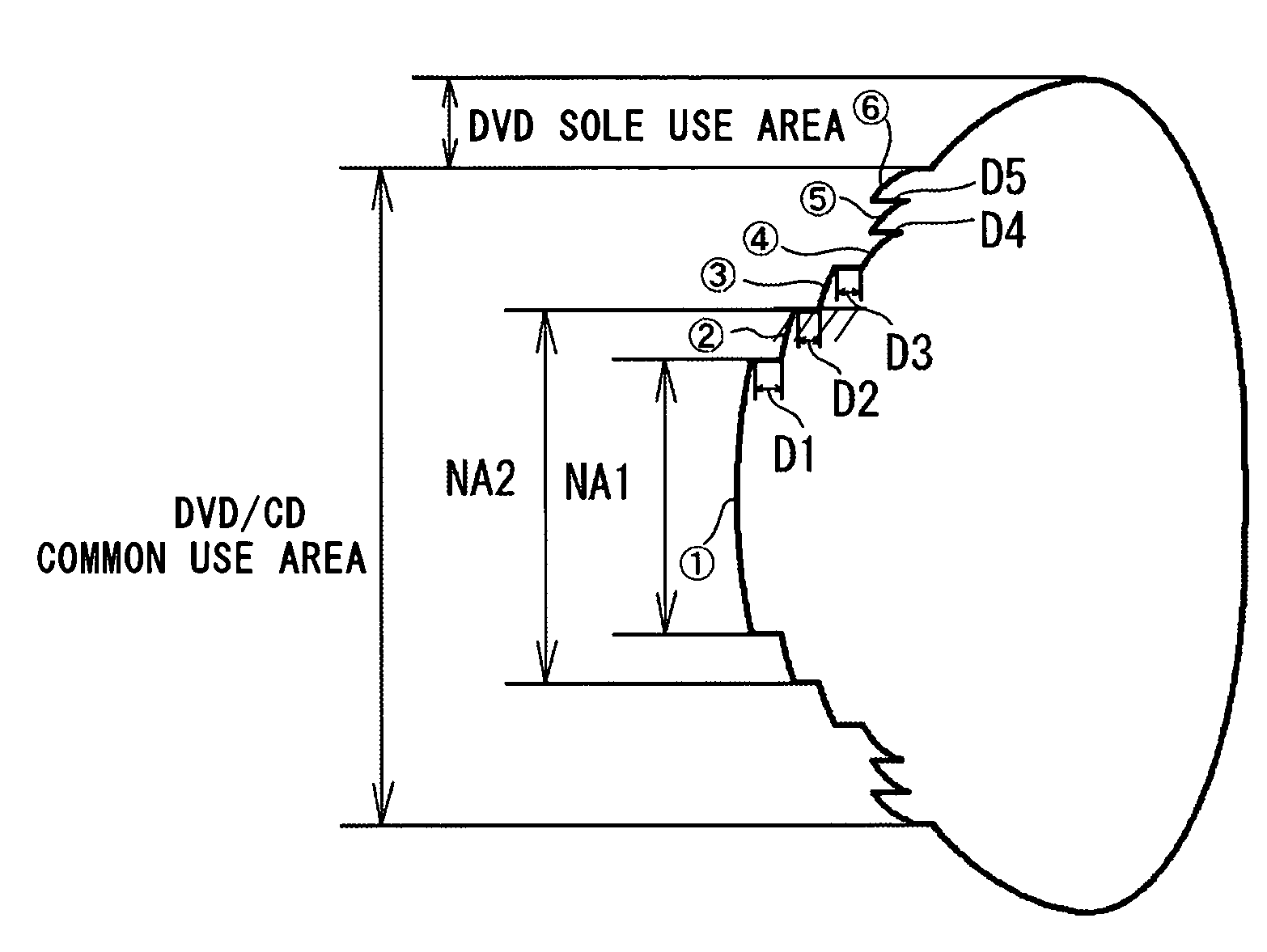Multi-wavelength lens, and optical system, optical head and optical disc apparatus using the lens
a multi-wavelength, optical head technology, applied in the direction of lenses, optical beam sources, instruments, etc., can solve the problems of inability to achieve 100% of the diffractive efficiency of different wavelengths at the same time, large area to remain inactive, etc., to achieve the effect of high light use efficiency
- Summary
- Abstract
- Description
- Claims
- Application Information
AI Technical Summary
Benefits of technology
Problems solved by technology
Method used
Image
Examples
first embodiment
[0073]FIGS. 1A and 1B are diagrams to show an objective lens according to the present invention, and FIG. 1A is for DVD, and FIG. 1B is for CD. In FIGS. 1A and 1B, reference symbol 1 denotes an objective lens according to the present embodiment, 2 denotes a transparent substrate of a DVD (which will be hereinafter referred to as DVD substrate), 3 denotes a transparent substrate of CD (CD substrate), and 4 and 5 denote laser beams.
[0074]In FIG. 1A, the optical lens 1 is mounted in an optical head (not shown) of an optical disc apparatus. A DVD is installed in the optical disc apparatus, and the objective lens 1 condenses the laser beam 4 as a parallel light, thereby processing recording or reproducing. Here, the DVD substrate 2 has the thickness t1 of 0.6 mm, and the laser beam 4 has wavelength λ1=655 nm, being a luminous flux having numerical aperture (NA)=0.63. Under such conditions, the laser beam is condensed on the information surface 2a formed on the DVD substrate 2 on the reve...
second embodiment
[0096]Now, the objective lens according to the present invention will explained herein below.
[0097]In the second embodiment whose basic structure is the same as the first embodiment, the light incident side A is radially sectioned into a plurality of zones from the optical axis, and each zone surface is configured so that the aberrations for both DVD and CD are reduced to fall within the allowable value.
[0098]The surface structure of the light incident side A according to the second embodiment will be explained hereinafter with reference to FIG. 2. The distance between the points a and b in a j-th zone from the optical axis OA in the direction of the light height h (in the radial direction) on the light incident side A is expressed by the following function ZAj
[0099]ZAj=B+Ch21+1-(K+1)C2·h2+A4·h4+A6·h6+A8·h8+A10·h10+A12·h12+A14·h14+A16·h16Formula9
The light height h in Formula 9 is that in the j-th zone.
[0100]The following table shows the range of h and the constant B, C, K, A4...
fourth embodiment
[0167]Further, to reduce the wavefront aberration for CD in Zone 2 in addition to in Zone 1, the fourth embodiment shown in Table 8 below may be used.
[0168]
TABLE 8FOURTH EMBODIMENTZONE jhBCKA4A61 0~0.464667 04.45390E−01−6.674830.0275 1.026695 20.464667~0.687967 0.001084094.46999E−01−8.52884E−01−1.11390E−03 8.21580E−0330.687967~0.904685 0.002168184.45826E−01−5.85171E−012.36910E−03−5.00360E−03 40.904685~1.414529 0.003252264.46759E−01−6.51167E−019.59140E−044.83750E−0451.414529~1.519145 0.002168184.28660E−01−3.27869E−016.74850E−033.92010E−0461.519145~1.589366 0.001084094.42061E−01−5.75461E−012.50970E−031.75070E−0471.589366~1.847991 0.001030734.45481E−01−6.24870E−011.77360E−031.24130E−0481.847991~2.2 −0.001137444.45319E−01−6.13552E−011.64620E−031.15930E−04ZONE jA8A10A12A14A161−14.364412 106.233381 −431.806672 895.812958 −725.25403 2 9.75070E−03−3.03780E−02−4.03770E−021.80080E−01−2.00000E−013 4.59410E−03 3.04280E−03−8.16540E−036.55040E−03−2.40830E−034 2.53240...
PUM
| Property | Measurement | Unit |
|---|---|---|
| thickness | aaaaa | aaaaa |
| thickness | aaaaa | aaaaa |
| wavelength | aaaaa | aaaaa |
Abstract
Description
Claims
Application Information
 Login to View More
Login to View More - R&D
- Intellectual Property
- Life Sciences
- Materials
- Tech Scout
- Unparalleled Data Quality
- Higher Quality Content
- 60% Fewer Hallucinations
Browse by: Latest US Patents, China's latest patents, Technical Efficacy Thesaurus, Application Domain, Technology Topic, Popular Technical Reports.
© 2025 PatSnap. All rights reserved.Legal|Privacy policy|Modern Slavery Act Transparency Statement|Sitemap|About US| Contact US: help@patsnap.com



